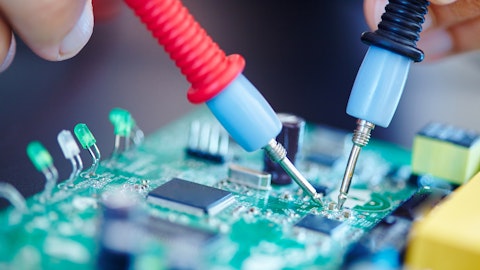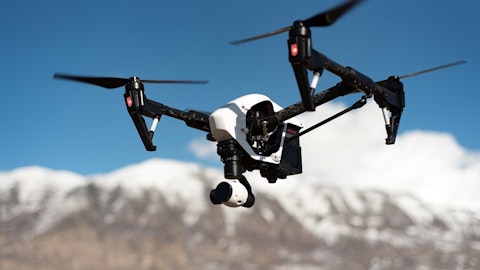Ambarella, Inc. (NASDAQ:AMBA) Q3 2024 Earnings Call Transcript November 30, 2023
Ambarella, Inc. beats earnings expectations. Reported EPS is $-0.28, expectations were $-0.39.
Operator: Thank you for standing by and welcome to Ambarella’s Third Quarter Fiscal Year 2024 Earnings Conference Call. [Operator Instructions] I would now like to hand the call over to VP, Corporate Development, Louis Gerhardy. Please go ahead.
Louis Gerhardy: Thank you, Latif. Good afternoon, everyone and thank you for joining our third quarter fiscal year 2024 financial conference call. On the call with me today is Dr. Fermi Wang, President and CEO; Brian White, CFO; and John Young, VP of Finance. The primary purpose of today’s call is to provide you with information regarding the results for our third quarter fiscal year 2024. The discussion today and the responses to your questions will contain forward-looking statements regarding our projected financial results, financial prospects, market growth and demand for our solutions, among other things. These statements are based on currently available information and subject to risks, uncertainties and assumptions.
Should any of these risks or uncertainties materialize or should our assumptions prove to be incorrect, our actual results could differ materially from these forward-looking statements. We are under no obligation to update these statements. These risks, uncertainties and assumptions as well as other information on potential risk factors that could affect our financial results are more fully described in the documents we filed with the SEC. Access to our third quarter fiscal 2024 results press release, transcripts, historical results, SEC filings and a replay of today’s call can be found on the Investor Relations page of our website. The content of today’s call, as well as the materials posted on our website are Ambarella’s property and cannot be reproduced or transcribed without our prior written consent.
Fermi will now provide a business update for the quarter. Brian will review the financial results and outlook, and then we will be available for your questions. Fermi?
Fermi Wang: Thank you, Louis, and good afternoon, everyone. In a challenging market, our fiscal Q3 revenue was slightly above the midpoint of our guidance. Our business appears to be in the process of stabilizing as our customers seem to be making progress with their inventory management efforts. We expect our customers to emerge from the cynical downturn at different times throughout the next year. And considering all of the dynamics at this time, we continue to anticipate we will return to growth in fiscal year 2025. We remain determined and focused on our strategic R&D priorities for the introduction of a portfolio of AI SoCs and software, targeting more sophisticated AI inference workloads. Our confidence in the secular growth opportunity for inference AI processors and software remain high.
And our long-term serviceable market opportunity CAGR estimate has not changed. Our CV2 family of SoCs is expected to lead us out of a cynical long term and represent a larger proportion of our total revenue in fiscal year 2025. As a reminder, this product family established Ambarella in the AI inference market, and these SoCs are expected to approach 60% of our total revenue in fiscal ‘24. In a single chip, the CV2 products typically provide both video processing and AI inference processing for one or more cameras. The average selling price of this product is close to $20 with a range of below $10 to above $50. In particular, I want to point out that CV5, the flagship of CV2 family and Ambarella first 5-nanometer SoC is forecast to generate meaningful revenue next year with more than 10 customers in production.
Our CV3 platform is expected to generate production revenue from the automotive market in calendar year 2026 and beyond. The CV3 platform includes a founding SoC and software, and we began to sample the CV3-AD SoC a year ago. And today, I’m pleased to announce during Q3, we received the first silicon for CV3-685 SoC, the flagship CV3 portfolio. And we are in the midst of a successful up of this extremely sophisticated $10 billion-plus transistor SoC. We expect to deliver engineering samples to customers in Q1 next year, and we are on track due the previously announced award from Continental to the first OEM stock production in calendar year 2027. CV3 SoCs are based on our third-generation AI inference technology and serve significantly more challenging AI inference workload such as a partial or complete autonomy in vehicles.
In addition to providing, in a single SoC, the perception processing for multiple camera input, CV3 SoC, for the first time, enables centralized processing of low-radar data as well as deep low-level fusion with data from other sensing modalities. The CV3 family SoC range in price from $50 to more than $400 per SoC. There are two additional elements of our CV3 platform, both of which are software. This includes Oculii Adaptive AI radar perception software and our complete autonomous driving software stack, both optimized for CV3. Since November ‘23, we have been providing thermal rights to OEMs and Tier 1s based on CV3 SoCs and our autonomous driving stack with centralized radar processing, low-level fusion and the Oculii radar perception software.
And we will continue to demo this at the CES in January. Now I would like to provide an update on our gen AI plan. During the last quarter, with the implementation of new software building blocks on CV3-8D, we have now successfully demonstrated inference rounding [indiscernible] model with the SoC using LPDDR memory instead of high-bandwidth memory and operating at a fraction of the power consumption of incumbent solutions. Some of our existing customers are evaluating how they will implement gen AI and large language models at the age of their networks. With our successful demos and additional analysis, we have concluded the powerful and highly efficient AI inference processor embedded in our CV3 SoCs is well suited for these markets. We will have more updates on our LLM strategy at CES 2024.
Once a year, we update our automotive funnel, which is meant to be a reference for our automotive customer engagements over the next 6 years. We completed the formal update in November and it increased 4% from $2.3 billion to $2.4 billion. The funnel is comprised of 1 business of about $800 million and a pipeline of about $1.6 billion. With our automotive business expected to generate about $80 million in revenue this year, the $2.4 billion 6-year funnel is an indication of the strong growth we anticipate from the automotive market. There was a significant number of upward and downward revision in the funnel calculation this year, including forecast changes and project delays from both Tier 1s and OEMs, projects won or lost in the pipeline and the addition of new projects.
CV3 represents a large portion of the current funnel even though CV3 revenue is not expected to commence until calendar year 2026. I will now discuss represented customer engagement in this quarter. In automotive, we are continuing to win new designs in China, the world’s largest automotive market. The open architecture of CVflow AI SoCs enables leading Chinese Tier 1s and ADAS software providers to develop highly differentiated fully featured solutions. During the quarter, GAC introduced 4 new passenger cars models incorporating Ambarella’s CV22AQ automotive SoCs in intelligent ADAS systems. This included GAC Trumpchi E8 and ES9 and Aion Hyper HT and Aion S Max. Also, Hycan introduced its V09 minivan with ADAS system also based on our CV22AQ.

And the SAIC introduced its Maxus Datong 7 minivan, including a camera monitor system, replacing left and the right mirrors and based on our CV22FS functional safety SoC. In the automotive aftermarket, Asia market leader [indiscernible] introduced its QXD DVR based on our CV25 AI SoC and the F200 Pro two-channel DVR based on our A12A SoC. And the European market leader, Nextbase, introduced its IQ Smart Dashcam product line using our CV22 automotive SoC, featuring 4K resolution and advanced AI-based threat detection. In the enterprise security camera market, a number of leading manufacturers introduced new cameras based on our flagship 5-nanometer CV5 and the CV52 families. Motorola introduced its new H6A product line featuring AI-based video analytics and up to 8-megapixel resolution based on our CV52 AI processors.
And Japanese market leader, i-PRO announced its new X series featuring total 9-model spending box indoor door and outdoor door models up to 8-megapixel based on CV52 SoCs. And the Korean market leader, [indiscernible] introduced its C-34404 multidirectional outdoor camera based on our CV5 SoCs. Also during the quarter, Verkada introduced CP52-E pan-tilt-zoom camera based on our CV22 SoC, offering camera operators dynamic coverage of wide areas and featuring 5-megapixel resolution and 20x optical zooms. And Germany, IDS introduced its first Ambarella-based camera, the [indiscernible] life imaging analysts based on our CV22 AI SoCs. In the smart home segment, Signify, the Philips Lighting spin-off known for its Hue lighting products, announced its Philips Hue secure cameras.
Based on our CV AI SoCs, the cameras can work with Hue lights to control lighting and sound alarms to deter intruders. Also during the quarter, [indiscernible], a leading home automation companies, announced its smart camera based on our CV28 AI SoCs. In November, Insta360 introduced its Ace Pro and Ace Action camera based on our CV5 and the CV52 AI SoCs. The Ace Pro is the first 8K consumer action camera, and both cameras include advanced AI features such as new network-based noise reduction, 48-megapixel computational photography, voice and gesture control and automatic video editing. Collectively, you can see overall design win activity is healthy across 13 different representative customers for 17 different projects, nine in auto and eight in IoT.
Furthermore, 16 of the 17 representative engagements utilize our higher-value AI SoCs. You can also see we are successfully implementing more sophisticated AI workload in our SoCs as highlighted with the identification of four different CV5 customer engagements. Looking forward, we believe our newer products such as CV5, CV72, and CV3 are well positioned to support increasingly sophisticated AI inference workloads, and this new product ramp and as we also capture more software value, we believe we can capture more value per design win. Now I would like to give an update on changes to our management team We previously announced in October 18, 2023. Brian, our CFO, will retire from his role as the CFO at the conclusion of the current fiscal year ending January 31, 2024.
I would like to thank his contributions to the company, including helping navigate the challenging inventory correction the semiconductor industry is currently experiencing, as well as continuing to strengthen our financial team and position us for success as we continue our transition into larger markets. I’m also pleased to announce that John Young, currently our VP of Finance, will assume the role of CFO on February 1, 2024. John has been with Ambarella for more than 6 years, serving a variety of finance and accounting roles, and we are confident that he will continue to be a valuable contributor as we seek to drive our transformation forward and grow shareholder value. Now I will hand it over to Brian to discuss the Q3 results and outlook in more detail.
Brian White: Thanks, Fermi. Before I begin, I’d like to thank Fermi and the Board for the opportunity I’ve had to be part of the special team here at Ambarella. The timing of my upcoming transition is facilitated by the progress we’ve made in developing the people, processes and tools to support Ambarella at the next levels of growth and profitability. I have complete confidence in John’s ability to take over as CFO and the team he has to support him. I look forward to their ongoing success. I’ll now review the financial highlights for our third fiscal quarter and provide a financial outlook for our fourth quarter ended January 31, 2024. I’ll be discussing non-GAAP results and ask that you refer to today’s press release for a detailed reconciliation of GAAP to non-GAAP results.
For non-GAAP reporting, we have eliminated stock-based compensation expense along with acquisition-related and restructuring costs adjusted for the impact of taxes. For fiscal Q3, revenue was $50.6 million, slightly above the midpoint of our prior guidance range, down 19% to the prior quarter and down 39% year-over-year. As expected, the sequential decline in revenue was driven primarily by our IoT end market. Non-GAAP gross margin for fiscal Q3 was 62.6%, in-line with our prior guidance range. Non-GAAP operating expense was $44.1 million, down $1.9 million from the prior quarter and below our prior guidance range of $46 million to $49 million, driven by continued expense management and the timing of spending between quarters. We remain on track to our internal product development milestones.
Q3 net interest and other income was [Technical Difficulty] and our non-GAAP tax provision was approximately $650,000. We reported a non-GAAP net loss of $11 million or $0.28 loss per diluted share. Non-GAAP EPS was $0.11 better than the implied midpoint of our prior guidance range, driven primarily by lower operating expenses. Now I’ll turn to our balance sheet and cash flow. Fiscal Q3 cash and marketable securities increased $5.8 million to $222.3 million. DSO improved from 45 days in the prior quarter to 42 days, while days of inventory improved from 147 to 145 days, down $4 million from the prior quarter. Cash from operations was $7.9 million and capital expenditures for tangible and intangible assets was $2.4 million. Free cash flow, defined as cash from operations less CapEx, was 11% of revenue for the quarter and 6% on a trailing 12-month basis.
We had three logistics and ODM companies represent 10% or more of our revenue in Q3. WT Microelectronics, a fulfillment partner in Taiwan, that ships to multiple customers in Asia, came in at 54% of revenue. Ciccone and ODM who manufactures for multiple IoT customers was 12% of revenue, and Hakuto, a logistics partner who primarily supplies multiple automotive customers in Japan was also 12% of revenue. Now I’ll discuss the outlook for the fourth quarter fiscal year 2024. The near-term revenue outlook appears to be stabilizing. While customers continue to manage their inventory levels and some pockets of end demand softness persist, ordering patterns and customer feedback suggests that our revenue is leveling out and likely to resume growth in our next fiscal year.
For fiscal Q4, we estimate that our total revenue will be in the range of $50 million to $53 million, with IoT up slightly and automotive about flat. At this time, we anticipate the sequential revenue growth will continue in our fiscal Q1 in the low to mid-single-digit percentage range. We expect fiscal Q4 non-GAAP gross margin to be in the range of 62% to 63%. We expect non-GAAP OpEx in the fourth quarter to be in the range of $45 million to $48 million, with the increase compared to Q3 driven by CES marketing activities, R&D tied to new product development and less favorable foreign exchange impacts. We estimate net interest income to be approximately $1.5 million, our non-GAAP tax expense to be approximately $600,000 and our diluted share count to be approximately 40.4 million shares.
Ambarella will be participating in a fireside chat and hosting one-on-one group meetings on December 5 and 6 at NASDAQ’s and Morgan Stanley’s London Conference. We also will be participating in Omero’s CES 101 Conference in Las Vegas on Monday, January 8. We expect to host more than 20 investor groups during our CES 2024 exhibition from January 9 to January 12. Please contact sell-side analysts to make reservations. We will also present and host one-on-one and group meetings at the Needham Conference on January 17 in New York. Please contact us for more details. Thank you for joining our call today. And with that, I’ll turn the call over to the operator for questions.
Operator: Thank you. [Operator Instructions] Our first question comes from the line of Joe Moore of Morgan Stanley.
See also 25 Countries with Best Quality of Life for Expats and 25 Best Cities Where You Can Retire On $3500 A Month.
Q&A Session
Follow Ambarella Inc (NASDAQ:AMBA)
Follow Ambarella Inc (NASDAQ:AMBA)
Joe Moore: Great. Thank you. I wonder if you could talk about the adjustments, Fermi, that you discussed to the funnel. You had said that you saw some business kind of coming out, and I know you had a number of businesses there that were probability weighted. What’s happening to that when that happens? Is that because the programs are just moving more slowly? Is it competitive? Is it supply chain? Can you just kind of give us an indication of why there would be those adjustments?
Fermi Wang: Yes. Thank you, Joe. I think let me address that question. In fact, in the script, we talked about four different factors. The first factor is the forecast change from Tier 1 and OEMs. For example, for some of the projects that we have won, the forecast of those projects would reduce particularly in the last several months we start seeing that trend. So that’s the first factor. The second factor is we start seeing project delays. For example, for some of the projects that we have won, the production date is pushing out and also for some projects that we are in an RFQ phase, the decision of those – of the final decision of the award is also got push out. So I think that’s the second factor. But also there are – the third factor is really that we continue to have a new project or RFQ that we’re bidding on, and we have different multiplier, like you said, different confidence level for different projects, and that’s a new project will be done.
The last factor is really the project that we won and lost at the end. So if you ask me, I think the first and second factor really negatively impact our funnel number, but the third and fourth – the net effect in the third and fourth probably help us to continue to add numbers into the funnel. So that’s the reason we have this minor increase on the funnel numbers.
Joe Moore: Great. That’s helpful. Thank you. And there’s still an awful lot of growth over multiple years [indiscernible] 5 years. So how does that profile look versus a year ago? I know you’ve talked about a lot of success in China. Do you see more of a China skew to your numbers in the next – as you start to ramp the advanced CV features?
Fermi Wang: Right. So I think that first of all, this funnel – first of all, on the one portion, this is the first time we start seeing CV3 contribution there. In the pipeline, definitely CV3 continue to getting higher and high percentage of funnel number. One thing I can say that in addition to the first CV3 design win, we announced last 2x ago with Conti, we add extra non-Chinese commercial vehicle design wins with CV3 and in this pipeline. So we definitely continue to make progress on that. And the trigger for those design wins is after we demoed the working CV3-685 chip and also demoed software stack we talk about, our AI software stack that can integrate all from the fusion to the radar as well as all the past planning. So we successfully demoed those things to OEM Tier 1s. Those two factors help us to secure the design wins we just talked about.
Operator: Thank you. Our next question comes from the line of Tore Svanberg of Stifel.
Jeremy Kwan: Yes. Good afternoon. This is Jeremy Kwan calling for Tore. I guess first, I just wanted to follow-up a little bit more on the adjustments you made to the funnel. Can you talk about how maybe, on a broad level, how maybe did the overall market in terms of maybe SAR impacted? And how much that may have impacted the slight increase in the funnel? And then I’ve got a follow-up after that.
Fermi Wang: I think the global market definitely impacts two things. One is the forecast of the run-rate of the project [indiscernible]. But also, I think you can read a lot of articles talking about for the Level 2+ or Level 3 cars, a lot of the new project the decision got pushed out because people are having different thoughts about their software stack, what’s the function features and particularly how to compete with China with their aggressive product line. So, I think all of those contribute to the first and second factor I just mentioned.
Jeremy Kwan: Great. And then moving to the AI inference accelerator business that you have successfully demonstrated, are we right to read into it that it sounds like this is something that you are moving forward with? And can you talk about maybe your competitive positioning relative to whether it’s the current incumbents, the number of private companies that are in the space and maybe other large competitors that might start to move in. Can you just talk a little bit about…?
Fermi Wang: Yes. I think you are referring to the ARM. So, I think first of all, this time a little bit different than the last time. Last time, we talked about global, a lot of different applications because we haven’t spent enough time on the marketing side. This time, we are kind of zooming to say while we understand our strength is Edge devices, particularly because we are in the market and we know a lot of customers in there. And we have also done enough demos and also talking to customers to understand our strengths against our competitor, both for large companies, also start-up companies. And our strength is, first of all, we have a working silicon that we can give demo at a very good performance, at very low power consumption.




